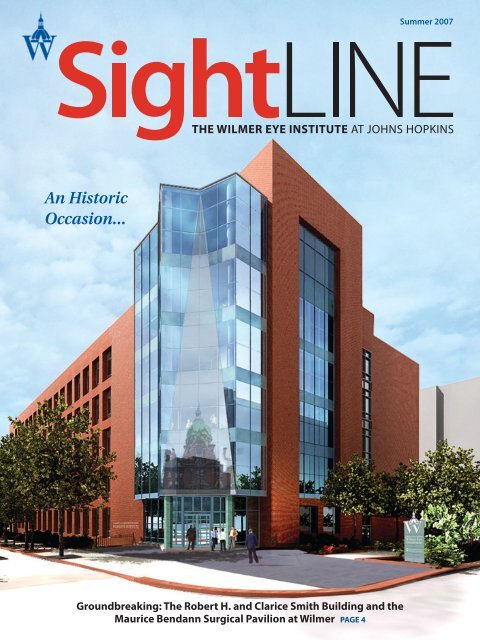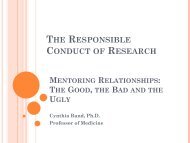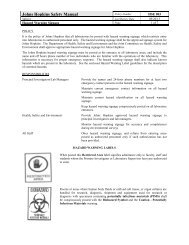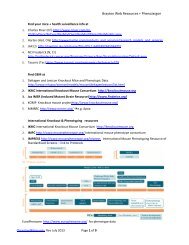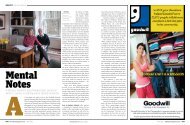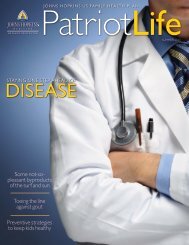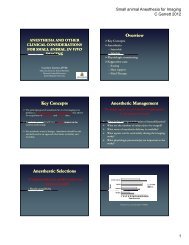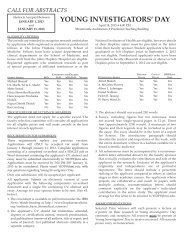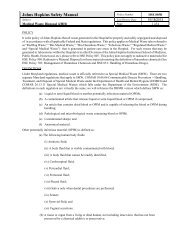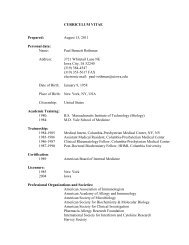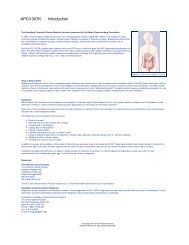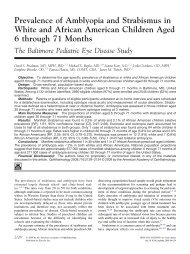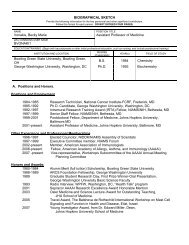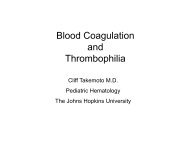An Historic Occasion... - Johns Hopkins Medical Institutions
An Historic Occasion... - Johns Hopkins Medical Institutions
An Historic Occasion... - Johns Hopkins Medical Institutions
Create successful ePaper yourself
Turn your PDF publications into a flip-book with our unique Google optimized e-Paper software.
<strong>An</strong> <strong>Historic</strong><br />
<strong>Occasion</strong>...<br />
Groundbreaking: The Robert H. and Clarice Smith Building and the<br />
Maurice Bendann Surgical Pavilion at Wilmer PAGE 4<br />
Summer 2007
2 S i g h t L I N E • T H E W I L M E R E Y E I N S T I T U T E<br />
Inside this Issue<br />
On the Cover:<br />
4 Groundbreaking<br />
Wilmer breaks ground on the new<br />
Robert H. and Clarice Smith Building<br />
and the Maurice Bendann Surgical<br />
Pavilion on June 6th<br />
10 Professorship Advances<br />
Macular Degeneration<br />
Research<br />
The G. Edward and G. Britton Durell<br />
Professorship is dedicated<br />
12 Morton F. Goldberg, M.D.,<br />
Director’s Discovery Fund<br />
A global approach to treating angle<br />
closure glaucoma<br />
14 The Lions Club Celebration<br />
Group reaches $4 million endowment<br />
to fund the Lions Vision Research and<br />
Rehabilitation Center<br />
16 W. Richard Green, M.D.<br />
Professorship<br />
Dedicated on May 18th<br />
18 Wilmer Alumnus Receives<br />
Top Honors<br />
James P. Gills, Jr., M.D. is named a<br />
Distinguished <strong>Medical</strong> Alumnus and is<br />
inducted into the Society of Scholars<br />
Architect rendering of the new Robert H. and Clarice Smith Building and<br />
the Maurice Bendann Surgical Pavilion of the Wilmer Eye Institute<br />
The View from Wilmer Development<br />
Five years ago, when I joined<br />
the Wilmer development<br />
staff, I worried that I might<br />
never “get up to speed” on<br />
all of the extraordinary work<br />
being done by Wilmer clini-<br />
cians and scientists. I was<br />
absolutely right! The na-<br />
ture of science and medicine in a place like <strong>Johns</strong><br />
<strong>Hopkins</strong> is such that things are always evolving,<br />
improving, changing: research yields discovery and<br />
discovery brings progress. Wilmer has more than<br />
100 full-time faculty members, each of whom is de-<br />
termined to do his or her best to make a positive<br />
difference in Wilmer’s mission to find new treat-<br />
ments and eventual cures for blinding eye diseases.<br />
There would probably be something amiss if a lib-<br />
eral arts major (such as I) could keep up with their<br />
progress!<br />
What the Wilmer development team can do is our<br />
utmost to find the philanthropic support needed to<br />
help our brilliant faculty accomplish their goals.<br />
Some require a special piece of equipment for the<br />
lab, or money to fund a technician’s salary. Others<br />
need funding for a graduate fellow. We take tremen-<br />
dous pride in our role in helping them acquire the<br />
tools they need to succeed.<br />
Years ago, former Wilmer director Dr. Goldberg<br />
and current director Dr. McDonnell realized the<br />
critical need for a new research and eyecare facility<br />
at Wilmer. On June 6th, 2007, we broke ground for<br />
the Robert H. and Clarice Smith Building and the<br />
Maurice Bendann Surgical Pavilion. It is a magnifi-<br />
cent dream realized, and we are deeply grateful for<br />
the support of the generous donors (the majority of<br />
whom are not medical or scientific experts), listed<br />
on page 8 of this publication and to all of those who<br />
will help us complete the funding. Whether scien-<br />
tists or liberal arts majors, the quest to end blind-<br />
ness is what binds us together. m<br />
Laurette L. Hankins<br />
Director of Development<br />
lhankin2@jhmi.edu
June 6 marked an auspicious occasion in the eighty-<br />
three year history of the Wilmer Eye Institute, with<br />
construction commencing on a new research and<br />
surgical building. When completed, roughly two years<br />
from now, this magnificent structure will make Wilmer<br />
much larger, more modern and more attractive. But<br />
none of these adjectives captures the real reason this<br />
building is so important to us. The bottom line is that<br />
this building will make us better.<br />
• Better in surgery, as the new facility will permit us<br />
to operate much more efficiently, performing ap-<br />
proximately 50% more operations. Patients will find<br />
the surgical experience much easier and “friendli-<br />
er,” with less waiting time. Surgeons and nurses will<br />
find it a better place to work, with less stress and less<br />
“busy work,” allowing more time to concentrate on<br />
our patients.<br />
• Better in research, as our scientists will no longer<br />
be limited by space. Also better because our scien-<br />
tists will work together in open “research neighbor-<br />
hoods”, where they will be able to share equipment,<br />
expertise and ideas to accomplish their work more<br />
rapidly and successfully.<br />
• Better healers in our clinics, as we redesign our clin-<br />
ical areas in our existing buildings to make them<br />
more patient- friendly. Our physicians will be able<br />
to work in teams to help the patients with multiple<br />
complicated problems who so often come to us and<br />
who need care from multiple specialties.<br />
From The DirecTor<br />
• Better educators in our clinics, laboratories and op-<br />
erating rooms, as our greater efficiency means more<br />
S i g h t L I N E • T H E W I L M E R E Y E I N S T I T U T E<br />
Reflecting on<br />
Wilmer’s Past while<br />
Looking Toward a<br />
Better Future<br />
time spent teaching the next generation of ophthal-<br />
mologists and scientists, and more time working in<br />
teams and teaching each other.<br />
Since my return to Wilmer four years ago, I have fre-<br />
quently found myself marveling at the talent, dedication<br />
and creativity of so many of the people who work at the<br />
“We shape our buildings.<br />
Thereafter, they shape us.”<br />
Winston Churchill<br />
Institute. Whatever kind words are said about Wilmer,<br />
and however prominently we appear in national rank-<br />
ings, Wilmer faculty and staff are never complacent.<br />
Rather, they are always looking for ways to improve. It is<br />
truly exciting to look toward the future and imagine how<br />
many patients in our country and throughout the world<br />
will benefit from the scientific discoveries and the much<br />
larger number of eye surgeries that this new building<br />
will make possible.<br />
On behalf of all who work at Wilmer, I offer heartfelt<br />
thanks to those generous individuals who made this<br />
ground breaking happen, and my gratitude, in advance,<br />
to those who will help us complete the funding for the<br />
entire transformational structure. Thank you for making<br />
us better. m<br />
Peter J. McDonnell, M.D.<br />
William Holland Wilmer Professor and Director
S i g h t L I N E • T H E W I L M E R E Y E I N S T I T U T E<br />
Groundbreaking Brings<br />
Wilmer’s Vision to Life<br />
Alan Guerrieri, Patti Guerrieri, Peter McDonnell, M.D., Morton Goldberg, M.D., Sandy Forsythe, Rick Forsythe, William Brody,M.D., Ph.D.,<br />
Ronald Peterson, Michael Liss, Robert Smith, Edward Miller, M.D. Clarice Smith, Michelle Smith, Arnall Patz, M.D., Robert Kogod,<br />
Arlene Kogod, Madeleine Pickens, T. Boone Pickens, William Tiefel, Norma Tiefel, Al Turner, Walter Stark, M.D., Glenn Turner<br />
The Wilmer Eye Institute is a giant step closer<br />
to realizing its dream of a new state-of-the-art<br />
facility to better serve patients and their fami-<br />
lies and to facilitate cross-disciplinary collaboration<br />
among researchers. Groundbreaking for the Robert H.<br />
and Clarice Smith Building and the Maurice Bendann<br />
Surgical Pavilion of the Wilmer Eye Institute at <strong>Johns</strong><br />
<strong>Hopkins</strong> was held June 6.<br />
More than 400 people gathered under a white tent at<br />
the future building site to cheer lead donor, Robert H.<br />
Smith, as he welded a sledgehammer to symbolically<br />
break through a mock glass wall that clouded the list of<br />
diseases and conditions of the eye that the Wilmer Eye<br />
Institute seeks to cure. In a moving ceremony that in-<br />
cluded remarks by leadership from Wilmer and <strong>Johns</strong><br />
<strong>Hopkins</strong> University, Smith spoke eloquently about his<br />
commitment to being of service to his fellow man and<br />
the happiness this brings him.<br />
After addressing the crowd that included Wilmer<br />
faculty, staff and friends, <strong>Johns</strong> <strong>Hopkins</strong> administra-<br />
tion, elected officials, and generous donors to Wilmer,<br />
Smith donned a hard-hat and declared, “The theme for<br />
today’s event is breakthroughs, so let’s go for a break-<br />
through, right here, right now.” Other major donors<br />
and <strong>Hopkins</strong> leaders joined him on stage for the fina-<br />
le. As Smith knocked down the wall, confetti cannons<br />
sounded and rained shiny bits of paper upon the audi-<br />
ence which rose for a standing ovation.<br />
“This is a key event in Wilmer’s history,” says Peter J.<br />
McDonnell, M.D., Wilmer’s Director and William Hol-<br />
land Wilmer Professor of Ophthalmology. “This build-<br />
ing will allow our researchers to move beyond any
physical and space limitations; they will be limited<br />
only by the brilliance of their ideas.”<br />
Located at the corner of Broadway and Orleans Street,<br />
the building will serve as the gateway to the historic <strong>Johns</strong><br />
<strong>Hopkins</strong> East Baltimore campus. “This building holds a<br />
premier site,” says J. Michael Barber, project manager<br />
and senior associate for Ayers/Saint/Gross, one of two<br />
architectural firms designing the facility.<br />
A major focus of the building’s design is to encour-<br />
age collaboration among researchers and allow those<br />
coming into the field an opportunity to associate in-<br />
formally with their experienced colleagues, explains<br />
Barber. From the patient perspective, Barber says, “The<br />
design and finishes throughout the outpatient and sur-<br />
gical areas clearly communicate that patients are be-<br />
ing treated in a world-class institution. In designing<br />
the operating rooms and recovery areas, we looked to<br />
improve both patient flow and efficiency.”<br />
Peter McDonnell, M.D., Morton Goldberg, M.D., Clarice Smith, Robert<br />
Smith, Arlene Kogod, Robert Kogod<br />
The building is named for Robert H. Smith and his<br />
wife Clarice, who is a member of the Wilmer Advisory<br />
Council. Smith drew on his 50 years of experience in the<br />
construction and real estate development business to<br />
serve as a catalyst in the building’s planning stages and to<br />
play a major role in accelerating the building’s timetable.<br />
“With every passing day, construction costs increase. We<br />
needed to move quickly to develop a timeline that would<br />
allow us to finalize completed plans and estimates as<br />
soon as possible,” acknowledges Smith, who worked<br />
S i g h t L I N E • T H E W I L M E R E Y E I N S T I T U T E<br />
closely with former Wilmer director Morton Goldberg,<br />
M.D. to streamline the pre-construction process.<br />
“This building is absolutely crucial for the future of<br />
the Wilmer Eye Institute and all of those who struggle<br />
with all types of eye disease,” says Smith, whose mother-<br />
in-law was treated by Wilmer ophthalmologists for age-<br />
related macular degeneration. “For me, it has become a<br />
passion to make this building happen now. Our gift is a<br />
“Our researchers ... will be limited<br />
only by the brilliance of their ideas.”<br />
Peter J. McDonnell, M.D.<br />
by-product of the reputation of <strong>Johns</strong> <strong>Hopkins</strong> and the<br />
quality of important initiatives Wilmer is undertaking.”<br />
Rick and Sandy Forsythe, co-chairs of Wilmer’s Ad-<br />
visory Council, have been involved with Wilmer since<br />
Rick began treatment for macular degeneration some<br />
five years ago. They have provided funding<br />
for AMD research and related lab equipment<br />
and have been leadership supporters of the<br />
new building. “This is an exciting moment<br />
for Wilmer. We have never forgotten our first<br />
visit to Wilmer and the level of service we re-<br />
ceived,” says Rick, who has worked tirelessly<br />
to build support for the new building. “There<br />
are so many treatments today that were not<br />
available five years ago. We are thrilled to be<br />
part of Wilmer’s progress.”<br />
“This building enables our surgeons to treat<br />
greater numbers of patients, who will find our<br />
state-of-the-art surgical facilities much easier to<br />
maneuver and more patient-friendly. Our peo-<br />
ple will work together more closely than ever,<br />
enhancing each other’s success in their clinics,<br />
operating rooms, laboratories, conference rooms, and<br />
even hallways,” adds Dr. McDonnell.<br />
Key areas in the building include the Maurice Ben-<br />
dann Surgical Pavilion and the T. Boone Pickens<br />
Atrium. “There are commonalities between the busi-<br />
ness Maurice Bendann built — Bendann Art Galleries<br />
— and the Wilmer Eye Institute. Each is based on rela-<br />
tionships and core values of quality, trust and loyalty.”<br />
says nephew Lance Bendann. “My uncle saw Wilmer as<br />
a place where quality of care was unmatched and unri-<br />
Continued on page 8
S i g h t L I N E • T H E W I L M E R E Y E I N S T I T U T E<br />
Robert Smith breaks through a mock glass<br />
block wall to reveal the new building
Morton Goldberg, M.D. congratulates Robert Smith<br />
during the ceremony<br />
William Brody, M.D., Ph.D.,<br />
Robert Smith, Clarice Smith,<br />
T. Boone Pickens<br />
S i g h t L I N E • T H E W I L M E R E Y E I N S T I T U T E 7<br />
Peter McDonnell, M.D., Rick Forsythe,<br />
Sandy Forsythe, Morton Goldberg, M.D.<br />
Peter McDonnell, M.D., Jan McDonnell, M.D.,<br />
Madeleine Pickens, T. Boone Pickens, Polly Stark,<br />
Walter Stark, M.D.
S i g h t L I N E • T H E W I L M E R E Y E I N S T I T U T E<br />
Groundbreaking Brings Wilmer’s Vision to Life<br />
Continued from page 5<br />
Laurette Hankins and Clarice Smith<br />
valed. He felt confident in placing his legacy in Wilmer,<br />
and wanted to assure Wilmer continued to be a valued<br />
and valuable leader in ophthalmologic care and an in-<br />
tegral part of Baltimore.”<br />
Major contributors to The Robert H. and Clarice Smith Building and the Maurice<br />
Bendann Surgical Pavilion of the Wilmer Eye Institute at <strong>Johns</strong> <strong>Hopkins</strong> Medicine<br />
As of 06/05/2007, commitments of $5,000 and greater include:<br />
$10,000,000 and above<br />
Maurice Bendann Trust<br />
Robert H. and Clarice Smith<br />
$5,000,000 to $9,999,999<br />
<strong>An</strong>onymous<br />
Robert and Arlene Kogod,<br />
the Charles E. Smith Family<br />
Foundation<br />
Forsythe Family Foundation<br />
James P. Gills, Jr., M.D. and<br />
Heather Gills<br />
T. Boone Pickens Foundation<br />
$1,000,000 to $4,999,999<br />
<strong>An</strong>onymous<br />
<strong>An</strong>onymous<br />
Forsythe Technology, Inc.<br />
Guerrieri Family Foundation, Inc.<br />
Lincy Foundation<br />
William and Norma Kline Tiefel<br />
Albert and Therese Turner Family<br />
$500,000 to $999,999<br />
Advanced <strong>Medical</strong> Optics<br />
H & R Blaustein Rosenberg<br />
Foundation<br />
James and Jacqueline McDonagh<br />
Joseph & Harvey Meyerhoff<br />
Charitable Fund<br />
$250,000 to $499,999<br />
Mr. and Mrs. Jack Kay<br />
Mr. and Mrs. William T. Young, Jr.<br />
$100,000 to $249,999<br />
Stephanie and Marshall Wishnack<br />
Fund<br />
Samuel B and Margaret C. Mosher<br />
Foundation<br />
$50,000 to $99,999<br />
Howard and Elaine Brownstein<br />
Norman Raab Foundation<br />
Drs. Peter and Jan McDonnell<br />
The five-story T. Boone Pickens Atrium increases<br />
natural light throughout the entire length of the build-<br />
ing and provides an attractive space for researchers<br />
to meet informally and give presentations and for the<br />
Institute to hold special events. “Advancing health<br />
services and treatment and medical research is a key<br />
component of my philanthropy,” says T. Boone Pick-<br />
ens, legendary oilman, philanthropist and member of<br />
the Wilmer Advisory Council. “One of my objectives is<br />
supporting world-class institutions of which Wilmer<br />
Eye Institute is clearly among. I am a frequent visitor<br />
and I am always impressed with the facilities and the<br />
expertise of the Wilmer team.”<br />
Construction is expected to begin immediately on the<br />
building with a target completion of summer 2009. m<br />
$25,000 to $49,999<br />
Catherine and Bruce Bass<br />
Beatrice C. Mayer Fund<br />
Harteveldt - Gomprecht Foundation<br />
Hecht-Levi Foundation, Inc.<br />
$10,000 to $24,999<br />
Lucy Young Hamilton<br />
Inspire Pharmaceuticals, Inc.<br />
Cristina and Harry Quigley<br />
$5,000 to $9,999<br />
Laurette L. Hankins<br />
Stratford C. Wallace<br />
All gifts of $100,000 and greater will<br />
be prominently recognized in the<br />
lobby of the new Wilmer building.
Pension ProTecTion AcT oF 2006 (PPA)<br />
S i g h t L I N E • T H E W I L M E R E Y E I N S T I T U T E<br />
<strong>An</strong> Incentive to Make an<br />
Outright Gift to <strong>Johns</strong> <strong>Hopkins</strong><br />
University from Your IRA<br />
On August 17, 2006, President<br />
Bush signed the PPA into law.<br />
The section of the law relating<br />
to tax-free distributions from<br />
traditional or Roth Individual<br />
Retirement Account (IRA) as-<br />
sets can prove to be beneficial<br />
to <strong>Hopkins</strong>’ benefactors. You<br />
should consult with your own financial advisor to see<br />
how the PPA can be beneficial to you.<br />
WHAT ARE THE BENEFITS OF THE PPA?<br />
• The Act allows a donor to transfer up to $100,000<br />
a year directly from an IRA to a qualified charity,<br />
like <strong>Johns</strong> <strong>Hopkins</strong> University, and not pay taxes<br />
on the funds.<br />
• The gift to the charity excludes the contribution<br />
from the donor’s adjusted gross income (AGI) and<br />
is not subject to the 50 percent of AGI deduction<br />
rule.<br />
• A distribution under the Act can satisfy your<br />
minimum distribution requirement.<br />
WHO IS ELIGIBLE FOR THE PPA?<br />
• The donor must be 70 1/2 years of age or older;<br />
• The distribution must go directly from the IRA to<br />
<strong>Johns</strong> <strong>Hopkins</strong> University;<br />
• Gifts cannot exceed $100,000 per taxpayer year in<br />
2006 and then again in 2007; and<br />
• Gifts must be outright (not to a donor-advised<br />
fund, support organization, charitable trust,<br />
pooled income fund, or charitable gift annuity).<br />
WHO CAN BENEFIT FROM THE PPA?<br />
• Donors who are required to take minimum with-<br />
drawals, but do not need additional income, can<br />
satisfy the distribution requirement with a trans-<br />
fer to <strong>Johns</strong> <strong>Hopkins</strong>.<br />
• Donors who have already taken the maximum<br />
charitable income tax deduction (by giving up to<br />
50 percent of their adjusted gross income) can<br />
now give up to $100,00 more from their IRA ac-<br />
counts because the IRA distribution is not subject<br />
to this limitation.<br />
• Donors who receive no tax benefit when they<br />
make charitable gifts, because they do not itemize<br />
their deductions.<br />
• Donors who are concerned that their IRA with-<br />
drawals will increase their AGI causing more of<br />
their social security income to be taxed.<br />
• Donors who want to support <strong>Johns</strong> <strong>Hopkins</strong> and<br />
have major assets residing in their IRAs.<br />
Please call the Office of Gift Planning for additional<br />
information at 1-800-548-1268 or 410-516-7954 or<br />
visit our website at www.jhu.plannedgifts.org
10 S i g h t L I N E • T H E W I L M E R E Y E I N S T I T U T E<br />
Durell Professorship Advances<br />
Macular Degeneration Research<br />
of Gerard A. Lutty, Ph.D.<br />
Jeanne Seelbach always wanted to honor the<br />
memories of her father, G. Edward Durell, and her<br />
brother, G. Britton Durell. Her philanthropic inter-<br />
ests led her to establish the Altsheler-Durell Founda-<br />
tion, through which she has funded gifts to the Wilmer<br />
Eye Institute, most recently the G. Edward and G. Brit-<br />
ton Durell Professorship.<br />
“There is great warmth in my heart for the research-<br />
ers at Wilmer and what they have accomplished. This<br />
endowment brings great joy to me,” says Mrs. Seelbach,<br />
whose father suffered from low vision all of his life and<br />
was eventually treated by Dr. Arnall Patz at Wilmer.<br />
Mrs. Seelbach was raised in Columbus, Ohio where<br />
her father was president of the Union Fork and Hoe<br />
Company. She was trained as a nurse at Massachusetts<br />
“This endowment provides a<br />
constant form of support, which<br />
gives continuity to research efforts<br />
that federal grants do not provide.”<br />
Gerard A. Lutty, Ph.D.<br />
General Hospital and had a long and distinguished<br />
nursing career in Louisville, Kentucky. There she met her<br />
husband, whose family built the famous Seelbach Hotel<br />
in Louisville. Mrs. Seelbach still resides in Louisville.<br />
In April, the inaugural G. Edward and G. Briton Du-<br />
rell Professorship was awarded to Gerard A. Lutty, Ph.D.,<br />
professor in the ophthalmology department.<br />
“Dr. Lutty is a gifted and accomplished scientist who<br />
has maintained consistently high levels of National In-<br />
stitute of Health grant funding for the last two decades,”<br />
says Peter J. McDonnell, M.D., Wilmer Director and Wil-<br />
liam Holland Wilmer Professor of Ophthalmology. “He<br />
has been recognized with many awards for his brilliant<br />
studies on retinal blood vessel growth in health and dis-<br />
ease, including macular degeneration. I know that the<br />
honor and support for his work resulting from the Durell<br />
Professorship has even greater significance for him.”<br />
Dr. Lutty received his B. S. degree in zoology and his<br />
M.S. in microbiology from the Catholic University of<br />
America inWashington, DC. He received his Ph.D. from<br />
the Biochemistry, Cellular, and Molecular Biology Pro-<br />
gram at <strong>Johns</strong> <strong>Hopkins</strong> University School of Medicine in<br />
1992.<br />
J. Baxter Schilling, Jerry Lutty, Ph.D., Chip Mason, Jeanne<br />
Durell, David Durell, Peter McDonnell, M.D., Arnall Patz, M.D.,<br />
Ronald Peterson<br />
“This endowment allows me to explore unique ther-<br />
apies used for age-related macular degeneration and<br />
other diseases involving nanoparticle delivery of thera-<br />
peutic genes to retinal pigment epithelial cells, the cells<br />
at the center of macular degeneration,” explains Dr. Lut-<br />
ty. “It is often difficult to acquire NIH funding for these<br />
novel concepts, which may provide exciting therapies in<br />
the future. This endowment provides a constant form of<br />
support, which gives continuity to research efforts that<br />
federal grants do not provide.”<br />
Dr. Lutty’s interest in the retinopathy of prematurity<br />
(ROP) spurred him to try to understand mechanisms by
which the retinal and choroidal vasculatures develop<br />
and how this development is affected by high oxygen,<br />
which occurs in ROP. In recent years, he has elaborated<br />
the unique ways in which these vasculatures develop in<br />
animals and man. In cell cultures, he has isolated pre-<br />
cursor cells that are involved in vascular development<br />
and hopes to use these precursors to deliver therapies<br />
for ROP. He has also focused on the ischemic retinopa-<br />
thies like sickle cell and diabetic retinopathy.<br />
His recent investigations have demonstrated differ-<br />
ences in sequential degeneration of the choroidal vas-<br />
culature and retinal pigment epithelial cells in different<br />
S i g h t L I N E • T H E W I L M E R E Y E I N S T I T U T E 11<br />
forms of AMD. This work suggests that wet and dry AMD<br />
have distinctly different etiologies or causes.<br />
Dr. Lutty has published more than 90 peer-reviewed<br />
articles and many chapters on sickle cell retinopathy,<br />
diabetic choroidopathy, AMD, ROP, retinal vascular de-<br />
velopment, and nanoparticles for gene therapy. He is a<br />
member of the editorial boards of Experimental Eye Re-<br />
search and Microvascular Research and reviews manu-<br />
scripts for every major ophthalmic journal. He has been<br />
previously honored by the American Heart Association,<br />
Research to Prevent Blindness Foundation and the Mac-<br />
ula Society. m<br />
Clockwise from top left:<br />
Jerry Lutty, Ph.D. and Peter McDonnell, M.D.;<br />
David Durell and Jeanne Durell<br />
David Durell, Jeanne Durell, Marialis Zmuda,<br />
Jerry Lutty, Ph.D., Arnall Patz, M.D.,<br />
J. Baxter Schilling
12 S i g h t L I N E • T H E W I L M E R E Y E I N S T I T U T E<br />
The morTon F. GolDberG, m.D., DirecTor’s DiscoVery FunD<br />
A Global Approach to Treating<br />
<strong>An</strong>gle Closure Glaucoma<br />
<strong>An</strong>gle closure glaucoma (ACG) is one of the lead-<br />
ing causes of blindness, and David S. Friedman,<br />
M.D., has traveled the world in the search for<br />
better ways to identify and treat the disease.<br />
Dr. Friedman, an associate professor at Wilmer and<br />
in the Department of International Health at <strong>Johns</strong><br />
<strong>Hopkins</strong> Bloomberg School of Public Health, brings the<br />
perfect combination of education and experience to<br />
his global research. He received his bachelor’s degree in<br />
East Asian studies from Yale University, his M.D. from<br />
Harvard University <strong>Medical</strong> School, a Master of Pub-<br />
lic Health from the <strong>Johns</strong> <strong>Hopkins</strong> University School of<br />
Hygiene and Public Health, and his Ph.D. from the De-<br />
partment of Epidemiology at the <strong>Johns</strong> <strong>Hopkins</strong> School<br />
of Medicine. As if that is not enough, he is fluent in<br />
Mandarin and conversant in Spanish and Indonesian.<br />
Dr. Friedman estimates that<br />
ultimately 1.5 billion people will<br />
benefit from the research.<br />
“There is good evidence that ACG can be detected<br />
in its early stage and lasers can be used to treat it pro-<br />
phylactically, but we are not sure which patients are at<br />
greatest risk,” says Dr. Friedman. Recent research in<br />
China and India found that close to two percent of indi-<br />
viduals over the age of 40 have ACG, and over 10% may<br />
benefit from laser treatments. “Given that almost half<br />
of the world’s population lives in China and India, mil-<br />
lions of individuals are at risk of developing ACG and<br />
may benefit from better screening strategies to identify<br />
them before glaucoma develops,” says Dr. Friedman.<br />
The decision to treat patients by performing a laser<br />
peripheral iridotomy (LPI) is often highly subjective<br />
and managing asymptomatic individuals poses a ma-<br />
jor public health problem if screening programs are to<br />
be undertaken in the developing world. “If LPI has any<br />
unrecognized side effects, for example, if it increases<br />
the rate of cataract formation, then widespread screen-<br />
ing and LPI treatment may cause more harm than good.<br />
This is especially true in developing countries where<br />
surgical services to treat cataract are not universally<br />
available,” says Dr. Friedman.<br />
Dr. Friedman’s research will help identify factors that<br />
predict who is at greatest risk of developing either acute<br />
David Friedman, M.D. in China<br />
or chronic angle closure and, ultimately, significant loss<br />
of vision. Once such factors are identified, more appro-<br />
priate screening and treatment recommendations can<br />
be made so that resources and treatments are appro-<br />
priately allocated.<br />
His work has recently been rewarded support from<br />
the Morton F. Goldberg, M.D., Director’s Discovery<br />
Fund. The fund, created in 2003 by the friends and col-<br />
leagues of Wilmer’s former director, enables the current<br />
director to provide critical funding to a select number<br />
of research projects with the greatest promise for pio-<br />
neering breakthroughs.<br />
“Dr. Friedman studies the prevalence and preven-<br />
tion of glaucoma in this country and abroad from three
distinct yet related disciplines: ophthalmology, epide-<br />
miology, and public health,” says Peter J. McDonnell,<br />
M.D., Wilmer’s Director and William Holland Wilmer<br />
Professor of Ophthalmology. “Building on his multi-<br />
disciplinary perspective, he has assembled one of the<br />
world’s most impressive group of researchers in this<br />
area. Their work holds great promise for the develop-<br />
ment of preventive therapies, particularly for angle clo-<br />
sure glaucoma, and we are happy to support Dr. Fried-<br />
man’s efforts with this award.”<br />
“Conducting research overseas is difficult,” says Dr.<br />
Friedman. “There are not that many agencies that pro-<br />
vide the needed resources, yet some of our biggest eye<br />
care problems are in developing countries. It is tremen-<br />
S i g h t L I N E • T H E W I L M E R E Y E I N S T I T U T E 1<br />
dously helpful to have seed money to support ongoing<br />
and new research.”<br />
Dr. Friedman has participated in studies in China and<br />
other parts of Asia in collaboration with world leaders<br />
in angle closure glaucoma research. “In order to under-<br />
stand the risks and benefits of prophylactic treatment,<br />
we plan to laser one eye of individuals participating in<br />
our study. This way we can determine if certain ocu-<br />
lar characteristics measured at baseline are important<br />
predictors of outcomes.” explains Dr. Friedman, who is<br />
looking to screen an additional 10,000 patients in Chi-<br />
na so that he can enroll 1,000 in a prospective study.<br />
This seminal research will guide the treatment of angle<br />
closure patients throughout the world. m<br />
Morton F. Goldberg, M.D., Director’s Discovery Fund Contributors<br />
To date, leading contributors to the Morton F. Goldberg, M.D. Director’s Discovery<br />
Fund have committed more than $2.51 million toward a goal of $3 million. As of<br />
06/01/2007, commitments of $5,000 and greater include:<br />
$500,000 and above<br />
Abraham* and Virginia Weiss<br />
$250,000 to $499,999<br />
Ms. Helen E. Day*<br />
Mr. and Mrs.William T. Young, Sr.*<br />
$100,000 to $249,999<br />
Alcon Foundation, Inc.<br />
<strong>An</strong>onymous<br />
Paula and William Bell<br />
Mr.* and Mrs. Leonard L. Greif, Jr.<br />
Mr. and Mrs. Kenneth Merlau<br />
Peter and Marilyn Parapiglia<br />
Rose Parapiglia<br />
$50,000 to $99,999<br />
Patricia and David Bernstein<br />
Mr. and Mrs. Howard Brownstein<br />
Charles J. Blair, M.D.<br />
Paula Brooks and Robert Cook<br />
Lee* and Albert H. Halff<br />
Mr. and Mrs. Charles Krasne<br />
Mr.* and Mrs. Donald Levinson<br />
Mr. and Mrs.* Leonard Newman<br />
$25,000 to $49,999<br />
Fred Brown<br />
Michael Elman, M.D.<br />
Dr. and Mrs. James Gills, Jr.<br />
Mr. and Mrs. Robert Katz<br />
Beatrice C. Mayer Fund<br />
Dr. and Mrs. Albert T. Milauskas<br />
Dr. Arnall and Ellen Patz<br />
Norman Raab Foundation<br />
Maureen A. and Albert T. Robinson<br />
$10,000 to $24,999<br />
<strong>An</strong>onymous<br />
Edmund F. and Virginia B. Ball<br />
Foundation<br />
George and Dolores Eccles<br />
Foundation<br />
The Funger Foundation, Inc.<br />
The Hultquist Foundation<br />
Arlene S. and Robert P. Kogod<br />
Alicia and Robert Kunisch, Sr.<br />
Jean M. and Edward B. Lipkin<br />
Helena Rubinstein Foundation<br />
Dr. and Mrs. Louis Slesin<br />
Robert H. Smith Family Foundation<br />
Ralph Terkowitz<br />
Jennifer S. and William J. Wood, M.D.<br />
$5,000 to $9,999<br />
William Finglass<br />
James H. Gray, M.D., P.A.<br />
Susan B. and Sanford D.Greenberg, Ph.D.<br />
Laurette L. Hankins<br />
Mr. and Mrs. Raymond Kwok<br />
Harriet and Jeffrey Legum<br />
Drs. Peter J. and Jan M. McDonnell<br />
Mrs. Robert H. Nixon<br />
Ralph O’Connor<br />
T. Boone Pickens<br />
Mr. and Mrs. Emanuel Shemin<br />
Stephanie and Marshall Wishnack<br />
*deceased
1 S i g h t L I N E • T H E W I L M E R E Y E I N S T I T U T E<br />
Multiple District 22 Lions Clubs<br />
Reach $ Million Endowment Goal<br />
The Lions Clubs have fulfilled a promise made more than two decades ago.<br />
This spring, Multiple District 22 Lions Vision Re-<br />
search Foundation, Inc., which represents some<br />
8,000 members of Lions Clubs throughout Mary-<br />
land, Delaware, and Washington, D.C., reached its $4<br />
million goal to fund the Lions Vision Research and Re-<br />
habilitation Center at the Wilmer Eye Institute.<br />
Low vision, a collective term for vision loss that can-<br />
not be reversed with medication or surgery, is one of the<br />
major areas of research at Wilmer and a major philan-<br />
thropic interest for the Lions Clubs. “In the<br />
United States, the number of Americans<br />
with low vision exceeds 3.5 million and is<br />
projected to double by 2030,” explains Pe-<br />
ter J. McDonnell, M.D., Wilmer’s Director<br />
and William Holland Wilmer Professor of<br />
Ophthalmology. “Clearly, this is a tremen-<br />
dous public health problem. We are thrilled<br />
that the Lions have decided to make sure<br />
the researchers in low vision at Wilmer<br />
have the funding to pursue the best ideas<br />
on how to improve care for these individu-<br />
als and enable them to remain productive,<br />
happy, and contributing citizens.”<br />
The Lions Clubs effort with Wilmer be-<br />
gan when Arnall Patz, M.D., director emer-<br />
itus of Wilmer, formalized the relation-<br />
ship between the two organizations. “Dr.<br />
Patz encouraged us to get involved in the mid 1980s,”<br />
explains John J. Shwed, general chairman of the Vi-<br />
sion 2000 Campaign since 1998. “Dr. Patz personally<br />
met Helen Keller and was aware of the challenge that<br />
she put before the Lions Clubs. He stirred the pot and<br />
pulled the Lions in this region together.”<br />
Dr. Patz met Helen Keller in 1965 when he received<br />
the coveted Albert Lasker <strong>Medical</strong> Research Award,<br />
sometimes dubbed the “American Nobel,” for proving<br />
the link between exposure to high levels of oxygen and<br />
blindness in infants and effectively ending the problem<br />
by suggesting ways to shield infants’ eyes during oxy-<br />
gen therapy. The vision of countless infants was saved.<br />
“Mrs. Lasker invited Helen Keller to make a presen-<br />
tation, after which Helen Keller suggested that I con-<br />
tact the Lions Clubs because the group focuses its ef-<br />
forts on people with visual impairment and those who<br />
help them. It was Helen Keller who directed me to the<br />
Lions and to the district serving my own state,” relates<br />
Dr. Patz.<br />
Robert Massof, Ph.D., Judith Goldstein, O.D., Morton Goldberg, M.D.,<br />
Peter McDonnell, M.D., Current Lions Vision Research Foundation Chairman<br />
and Past District Governor Ted Reiver, Vision 2000 Chairman and Past District<br />
Governor John Schwed, Arnall Patz, M.D., James Deremick, Gislin Dagnelie, Ph.D.<br />
“When you think about what the Lions Clubs have<br />
achieved, it is monumental,” he says. “With this en-<br />
dowment to the Low Vision Center, we are exploring<br />
new ways to improve treatment and rehabilitation<br />
measures. The support generated by the pioneering ef-<br />
forts of the Lions is overwhelming.”<br />
The Lions Clubs have a longstanding commitment<br />
to improving vision. “In 1925, Helen Keller challenged<br />
the Lions to be knights of the blind to fight against<br />
darkness,” explains Ted Reiver, 2006-2007 chairman<br />
of the Lions Vision Research Foundation, Inc. He de-
scribes the efforts in the area of vision as “the holy grail<br />
for the Lions Clubs. The completion of this endowment<br />
means lots of Christmas tree sales and spaghetti din-<br />
ners to raise $4 million for the endowment and ad-<br />
ditional funds to cover current expenses each year.”<br />
Reiver notes that the average Lions’ fund raising event<br />
yields $300 to $400; “that tells you how many events<br />
were held.”<br />
Today, Dr. McDonnell notes, “There is no other oph-<br />
thalmology department in the world with a Low Vision<br />
Center that is endowed to this magnitude with the re-<br />
sulting excellence. This has been a long-term labor of<br />
love for the Lions.”<br />
Morton F. Goldberg, M.D., the former director of<br />
S i g h t L I N E • T H E W I L M E R E Y E I N S T I T U T E 1<br />
Wilmer, attests to the dedication of the Lions Clubs in<br />
meeting their fund raising goal. “They have shown ex-<br />
traordinary perseverance in fulfilling their pledge and<br />
their prediction to make the endowment a reality. The<br />
Lions Clubs members are very generous people; they<br />
are fabulous citizens with an incredible generosity of<br />
spirit.”<br />
Clement F. Kusiak, 2004-2005 Lions Clubs Interna-<br />
tional president and 2005-2006 chair of the Lions Vi-<br />
sion International Foundation, affirms that District 22<br />
has been a trailblazer in its efforts to start the Low Vi-<br />
sion Center. “Our relationship with <strong>Johns</strong> <strong>Hopkins</strong> and<br />
with Wilmer has served as a model for many other low<br />
vision centers around the world.” m<br />
Research supported totally or in part by the Lions Clubs has led to<br />
solutions for patients suffering from eye diseases such as macular<br />
degeneration, diabetic retinopathy, and glaucoma.<br />
The series of projects include:<br />
U Model Diabetic Vision Rehabilitation Program, a needs assessment of diabetic low vision patients and an<br />
adapted diabetes self-care program to supplement diabetes education for visually impaired patients.<br />
U Low Vision Rehabilitation in the U.S. Healthcare System, a clinical model currently used at Wilmer for low<br />
vision evaluation and rehabilitation that has led to the standardization of low vision practice nationwide and<br />
Medicare coverage for low vision services.<br />
U Lions Low Vision Public Education, in conjunction with the National Federation of the Blind, creates public<br />
education materials about low vision and blindness and trains Lions volunteers to lead information sessions in their<br />
communities.<br />
U Contributions of Co-morbidities to Disabilities from Low Vision, an assessment of the proportion of low<br />
vision patients who have physical and mental health problems in addition to low vision and how physical and<br />
mental health combine with low vision to worsen the level of disability.<br />
U Preliminary Studies of Prosthetic Vision, the design of systems that create visual sensations in the blind by<br />
electrically stimulating the retina or visual part of the brain with implanted electrodes (e.g., “retinal chip”).<br />
U Clinical Program for the Low Vision Enhancement System (LVES), a model comprehensive, low vision<br />
rehabilitation program centered on patient evaluation and training for LVES (which was developed in the Lions<br />
Vision Research Center). The project also included training low vision rehabilitation professionals to implement<br />
the comprehensive program.<br />
U Issues in Low Vision Rehabilitation: Service Delivery, Policy, and Funding, a symposium on low vision<br />
rehabilitation practice standards and Medicare funding that resulted in a multi-authored book based on the<br />
symposium that was published by the American Federation for the Blind Press.<br />
U Low Vision Rehabilitation Online Network, a collaborative clinical research project involving over 1,400 low<br />
vision rehabilitation professionals.
1 S i g h t L I N E • T H E W I L M E R E Y E I N S T I T U T E<br />
W. Richard Green, M.D.<br />
Professorship Inaugurated<br />
Richard D. Sem-<br />
ba, M.D., M.P.H.,<br />
has been named<br />
the inaugural recipi-<br />
ent of the W. Richard<br />
Green, M.D. Profes-<br />
sorship. Throughout<br />
his career, Dr. Semba<br />
has studied nutritional<br />
blindness caused by vi-<br />
tamin A deficiency, the<br />
leading cause of sight<br />
loss among children<br />
worldwide.<br />
“Dr. Green has been<br />
an inspiration to me; he possesses an encyclopedic<br />
knowledge,” says Dr. Semba. “This professorship will<br />
allow me the freedom to pursue the study of blinding<br />
diseases in childhood and will allow greater time in the<br />
lab for bench research.”<br />
Dr. Semba has studied strategies to combat the un-<br />
derlying factors that place children at risk for nutrition-<br />
al blindness, including lack of immunizations, poor<br />
sanitation and hygiene, infectious diseases, low level of<br />
maternal education, poor dietary quality, and limited<br />
access to programs that provide vitamin A capsules. Dr.<br />
Semba previously received a Lew R. Wasserman Mer-<br />
it Award from Research to Prevent Blindness in 2006.<br />
“The prevention of nutritional blindness requires a dif-<br />
ferent model for the ophthalmologist,” says Dr. Semba.<br />
“The specialist cannot just wait in an eye clinic for a<br />
child to come through the door with blinding eye dis-<br />
ease. It is too little and too late.”<br />
W. Richard Green, M.D.<br />
Dr. Semba received his M.A. in Latin American Stud-<br />
ies and his M.D. from Stanford University. During<br />
medical school, while he did his ophthalmic residency<br />
at Wilmer, he conducted research on onchocerciasis<br />
(river blindness) in Venezuela, Mexico, and Liberia. He<br />
joined the Wilmer faculty in 1987 and became assistant<br />
professor in 1991, associate professor in 1997, and pro-<br />
fessor in 2006.<br />
“In his humble, quiet way, Dr. Semba has made sig-<br />
nificant contributions to the field. He has a remarkable<br />
research track record and he is in the top five percent<br />
of National Institute of Health-funded scientists,” says<br />
Peter J. McDonnell, M.D., Wilmer’s Director and Wil-<br />
liam Holland Wilmer Professor of Ophthalmology.<br />
Dr. Semba is now looking at how inflammation af-<br />
fects more common eye conditions such as macular<br />
degeneration and cataracts in two diverse populations:<br />
a group of older women in Baltimore and a group of<br />
older men and women in Italy.<br />
The professorship is named for William Richard<br />
Green, M.D., who is recognized internationally as one<br />
“The specialist cannot just wait<br />
in an eye clinic for a child to come<br />
through the door with blinding eye<br />
disease. It is too little and too late.”<br />
Richard D. Semba, M.D., M.P.H.<br />
W. Richard Green, M.D. Professor of Ophthalmology<br />
of the world’s foremost ophthalmic pathologists. “Dr.<br />
Green is known for using pathology to train ophthal-<br />
mologists to better understand how the eye works,”<br />
says Dr. McDonnell. “One of his major legacies is shap-<br />
ing the careers of future ophthalmologists. Just look at<br />
the list of contributors to his endowment and the pro-<br />
fessorship. The vast majority are future trainees, who<br />
not only speak well of him, but actively support him.”<br />
“I want to thank all the friends and colleagues whose<br />
contributions made the professorship possible. With<br />
this support behind him, I wish Dr. Semba continued<br />
success in his studies of tropical diseases in the field<br />
and laboratory,” says Dr. Green, who has been a stal-<br />
wart supporter of Wilmer throughout his career.<br />
Dr. Green received his medical degree from the Uni-
versity of Louisville School of Medicine, completed an<br />
internship in internal medicine at the New England<br />
<strong>Medical</strong> Center of Tufts University in Boston, and took<br />
postgraduate courses in ophthalmology at Harvard<br />
University, the Howe Laboratory, and the Retina Foun-<br />
dation in Boston. Following a two-year residency at the<br />
Wills Eye Hospital in Philadelphia, he joined <strong>Johns</strong> Hop-<br />
kins in 1968 as an assistant professor of ophthalmology<br />
and pathology. In 1977, Dr. Green became professor of<br />
ophthalmology and in 1993 was named professor of<br />
pathology. From 1989 - 2006 he was the International<br />
Order of Odd Fellows Professor of Ophthalmology.<br />
His career has included more than 700 publications,<br />
board certification in both ophthalmology and pathol-<br />
ogy, and the presidency of the American Ophthalmo-<br />
logic Society and the American Association of Oph-<br />
thalmic Pathologists. He has received more than 25<br />
national awards, including the “Greatest Living Oph-<br />
S i g h t L I N E • T H E W I L M E R E Y E I N S T I T U T E 17<br />
thalmologist Millennium Award” (1999), an award for<br />
the best book in clinical medicine for 1999, the Arnall<br />
Patz Medal from the Macula Society (2000), the Alcon<br />
Research Institute Award (2001), the Life Achievement<br />
Award of the American Academy of Ophthalmology<br />
(2001) and the guest of honor award, and a tribute from<br />
the Retina Society (2004). He was honored with a trib-<br />
ute in RETINA, The Journal of Retinal and Vitreous Dis-<br />
eases in its July/August 2005 issue.<br />
At <strong>Johns</strong> <strong>Hopkins</strong>, he has been recognized and hon-<br />
ored by the L. Harrell Pierce Wilmer Resident Teach-<br />
ing Award (1985), the L. Harrell Pierce and R.G. Mi-<br />
chels Wilmer Teaching Award (1991), the Excellence<br />
in Teaching Award by The <strong>Johns</strong> <strong>Hopkins</strong> University<br />
Alumni Association (1996), the perpetual designation<br />
of his laboratory as the “W. Richard Green Eye Pathol-<br />
ogy Laboratory” (1997), and the inception of the “W.<br />
Richard Green Housestaff Teaching Award (2000). m<br />
Left: Ronald Peterson, Jerry Schnydman,<br />
Richard Semba, M.D., M.P.H., W. Richard Green, M.D.,<br />
Peter McDonnell, M.D., Arnall Patz, M.D.<br />
Below: Walter Stark, M.D. and<br />
Richard Semba, M.D., M.P.H.<br />
Left: Janet Green, Gordon Green,<br />
Whitney Green, W. Richard Green, M.D.
1 S i g h t L I N E • T H E W I L M E R E Y E I N S T I T U T E<br />
<strong>Johns</strong> <strong>Hopkins</strong> University<br />
Bestows Top Honors on<br />
James Pitzer Gills, Jr., M.D.<br />
James P. Gills, M.D., was recently<br />
honored by <strong>Johns</strong> <strong>Hopkins</strong> Uni-<br />
versity with two of its highest<br />
awards. Dr. Gills was named a 2007<br />
Distinguished <strong>Medical</strong> Alumnus and<br />
was inducted into the University’s<br />
Society of Scholars.<br />
“It is wonderful to get confirma-<br />
tion of your achievements from an<br />
institution as great as <strong>Johns</strong> Hop-<br />
kins and Wilmer,” says Dr. Gills. “I<br />
am honored to part of the Wilmer<br />
family.”<br />
The Distinguished Alumnus Award<br />
honors alumni who typify the <strong>Johns</strong><br />
<strong>Hopkins</strong> tradition of excellence<br />
and bring credit to the University<br />
through their personal accomplish-<br />
ments, professional achievement, or humanitarian<br />
service. The Society of Scholars was created in 1967 to<br />
honor the accomplishments of men and women who<br />
spent part of their careers at <strong>Johns</strong> <strong>Hopkins</strong>. The soci-<br />
ety — the first of its kind in the nation — inducts for-<br />
mer postdoctoral fellows and former junior or visiting<br />
faculty at <strong>Johns</strong> <strong>Hopkins</strong> who have gained marked dis-<br />
tinction in their fields.<br />
“Dr. Gills represents the important role that Wilmer<br />
plays in training leaders in the field,” says Peter J. Mc-<br />
Donnell, M.D., Wilmer Director and William Holland<br />
Wilmer Professor of Ophthalmology. “He is both a suc-<br />
cessful businessman and surgical innovator whose<br />
surgical experience is second to none. We are thrilled<br />
that he is being honored for his excellence as a physi-<br />
cian and a teacher.”<br />
James P. Gills, Jr., M.D.<br />
Dr. Gills received his medical degree from Duke Uni-<br />
versity <strong>Medical</strong> Center and served his<br />
ophthalmology residency at Wilmer<br />
Eye Institute from 1962 to 1965. He<br />
founded the St. Luke’s Cataract and<br />
Laser Institute in Tarpon Springs,<br />
Florida. In 1974, Dr. Gills became the<br />
first eye surgeon in the United States<br />
to dedicate his practice to cataract<br />
treatment through the use of intra-<br />
ocular lens implants and has since<br />
performed more cataract and lens<br />
implant surgeries than any other eye<br />
surgeon in the world.<br />
In establishing his practice, Dr.<br />
Gills says, “I looked at what could<br />
benefit patients most and concen-<br />
trated on improving the quality of<br />
life for patients with cataracts.” His<br />
interest in raising the standard of care for ophthalmic<br />
patients has led to advances such as improved intra-<br />
ocular lens power accuracy, refinements of incision<br />
“I looked at what could benefit<br />
patients most and concentrated<br />
on improving the quality of life for<br />
patients with cataracts.”<br />
James P. Gills, Jr., M.D.<br />
techniques, and piggyback intraocular lenses. Dr. Gills<br />
introduced many formulations for intraocular antibi-<br />
otics and promoted the use of lidocaine intraocularly<br />
for cataract surgery, which he describes as one of his<br />
most significant achievements — one that has revolu-<br />
tionized the way the procedure is performed today.
Dr. Gills is recognized not only for his medical skills,<br />
but as a successful business owner. He is president of<br />
a variety of companies, including the World Triathlon<br />
Corporation (Ironman). He is an avid athlete and com-<br />
peted in 46 marathons, 30 triathlons, five Ironman rac-<br />
es, six Double Irons, and four 2,000-mile races.<br />
He has published more than 190 medical articles and<br />
authored or co-authored 14 books on ophthalmology.<br />
He has also written 18 books on Christian living, with<br />
more than six million books in print. His philanthropic<br />
work in more than 70 ministries and organizations led<br />
to his receipt of the Duke University 2005 Humanitar-<br />
ian Award and the 2002 William Carey Award for Ex-<br />
traordinary Leadership and Service in World Missions<br />
S i g h t L I N E • T H E W I L M E R E Y E I N S T I T U T E 1<br />
from Trinity College.<br />
Dr. Gills, who serves on the Wilmer Advisory Council,<br />
recently made a leadership gift of $5 million to Wilmer<br />
to support the Institute’s new Robert H. and Clarice<br />
Smith Building and Maurice Bendann Surgical Pavil-<br />
ion. “We are grateful that Dr. Gills has chosen to sup-<br />
port Wilmer’s mission with his incredibly generous phi-<br />
lanthropy. His supporting gift will allow our scientists<br />
and clinicians to have the best possible space to work<br />
together in to develop cures and treat patients,” adds<br />
Dr. McDonnell. Dr. Gills previously funded the James<br />
P. Gills Professorship in Ophthalmology and made the<br />
lead commitment for the endowment of the Frank B.<br />
Walsh Professorship in Neuro-ophthalmology. m<br />
Dr. Patz Receives Heritage Award<br />
Arnall Patz,<br />
M.D, Direc-<br />
tor Emeritus<br />
of the Wilmer Eye<br />
Institute, received<br />
the <strong>Johns</strong> <strong>Hopkins</strong><br />
University Heritage<br />
Award this spring.<br />
The award honors<br />
alumni and friends of<br />
<strong>Johns</strong> <strong>Hopkins</strong> who<br />
have contributed<br />
outstanding service<br />
over an extended pe-<br />
riod to the progress<br />
of the university or<br />
the achievement of the alumni association. This recog-<br />
nition is just the latest in a series of honors bestowed<br />
upon Dr. Patz for his groundbreaking research and his<br />
exemplary leadership in the field.<br />
“I have spent 53 years of my professional career<br />
at <strong>Hopkins</strong>,” notes Dr. Patz, who is still active on the<br />
Wilmer faculty. “This honor is for long-standing con-<br />
tributions, and I am happy to have been affiliated with<br />
<strong>Hopkins</strong> and the Wilmer Eye Institute for so many<br />
years.” The award was presented to Dr. Patz by <strong>Johns</strong><br />
<strong>Hopkins</strong> University President William R. Brody, M.D.,<br />
Ph.D. and Edward D. Miller, M.D., Chief Executive Of-<br />
ficer of <strong>Johns</strong> <strong>Hopkins</strong> Medicine.<br />
Dr. Patz has also been honored by his alma mater,<br />
Emory University, with the creation of the Arnall Patz,<br />
M.D. Lifetime Achievement Award by the Emory School<br />
of Medicine. The award will be inaugurated this fall with<br />
a presentation to Dr. Patz during Emory’s <strong>Medical</strong> Alum-<br />
ni Weekend. The distinction honors Emory University<br />
alumni who display extraordinary leadership and ac-<br />
complishment in the field of medicine at the national<br />
and international level. Dr. Patz was celebrated for his<br />
dedicated efforts in reducing the incidence of Retinopa-<br />
thy of Prematurity. “Emory University was the founda-<br />
tion of my medical career, and it is a privilege to be hon-<br />
ored with this important award,” Dr. Patz says. m
20 S i g h t L I N E • T H E W I L M E R E Y E I N S T I T U T E<br />
Wilmer Cares for the<br />
Underserved<br />
“Justice delayed is justice denied”<br />
William Gladstone, British Statesman and Prime Minister (1868-1894)<br />
People often ask me “what are you most proud<br />
of about Wilmer?” Commonly, the answer is<br />
not on the tip of my tongue, because I have to<br />
think about the many aspects of Wilmer’s mission, the<br />
many wonderful people who work here and the many<br />
wonderful things they do. Is it the excellent standard<br />
of medical care to which our physicians, nurses, tech-<br />
nical and support staff aspire daily? Is it the exciting<br />
discoveries achieved in our laboratories on the medi-<br />
cal school campus or in the large populations of pa-<br />
tients being treated and studied in African villages or<br />
in rural China? Is it the stellar young medical students<br />
and residents that we train, and who will go on to be-<br />
come tomorrow’s leaders in medicine and the field of<br />
ophthalmology? All these things are important, all of<br />
them are meritorious and all of them cause me to feel<br />
proud of being part of Wilmer. So it is sometimes hard<br />
to quickly answer this question, or to write a letter like<br />
this and focus on one particular aspect of Wilmer.<br />
But for this issue of SightLine I knew what I wanted to<br />
emphasize, and that is the great work of our house offi-<br />
cers and faculty in caring for the poor of East Baltimore<br />
and Maryland. As those of us who trained at Wilmer<br />
understand, one of our key privileges and responsibili-<br />
ties is to care for the indigent around us. To serve these<br />
individuals, we maintain a dedicated eye emergency<br />
room, open 24 hours a day, 7 days a week, 365 days a<br />
One of our key privileges and<br />
responsibilities is to care for the<br />
indigent around us.<br />
year (366 on leap years). We are the only designated Eye<br />
Trauma Center in the state of Maryland, and provide<br />
this service for citizens of adjoining states who suffer<br />
eye injuries and need our expertise. Our General Eye<br />
Service (GES) in the basement of Wilmer provides non-<br />
emergent eye care for our community as well.<br />
The main point is that Wilmer<br />
provides timely access to excellent<br />
eye care for those who need it.<br />
To paraphrase Mr. Gladstone, however, I strongly be-<br />
lieve that “Eye care delayed is eye care denied”. Some<br />
eye diseases, if not diagnosed and treated promptly,<br />
will lead to irreversible vision loss. How can a patient,<br />
not having pain, know if his or her visual symptoms de-<br />
mand prompt attention, or if they can safely wait for<br />
months for an appointment to become available?<br />
That is why I am so proud of our house officers. Re-<br />
cently, under the superb leadership of our Assistant<br />
Chief of Service, Dan Garibaldi, M.D., a practice con-<br />
sultant recommended by Wilmer alumnus James P.<br />
Gills, Jr., M.D. and our house officers reengineered how<br />
we run our GES. The results include the following:<br />
1. a reduction in the wait for a non-urgent appoint-<br />
ment from three months to two days<br />
2. a reduction in the wait time for patients to be reg-<br />
istered from 20 minutes to 5 minutes<br />
3. a 40% reduction in “no shows”, where a scheduled<br />
patients forgets or otherwise fails to keep his/her<br />
appointment<br />
4. a dramatic increase in the satisfaction of the pa-<br />
tients in the GES.<br />
What about our Eye Emergency Room? We moni-<br />
tor the waits of our level 1 trauma victims with urgent<br />
problems, and can document that they begin receiving<br />
care within minutes of arrival.<br />
All of this is expensive, of course. More than half of<br />
our eye trauma victims have no insurance whatsoever,<br />
and we typically receive no compensation for their care
whatsoever. The percentage of indigent patients seen in<br />
our GES is twice that in any of our other clinics. A sub-<br />
stantial portion of our endowment is dedicated to sup-<br />
port the costs of surgery for those who cannot pay, but<br />
as the number of uninsured (and in particular uninsured<br />
children) increases, those funds increasingly prove inad-<br />
equate. But the main point is that Wilmer provides time-<br />
ly access to excellent eye care for those who need it.<br />
Recently, a prominent department of ophthalmology<br />
in Canada sent me an annual report. The report listed<br />
all the measures used by that department to monitor<br />
itself. One achievement highlighted by the department<br />
was that the wait time for an appointment achieved<br />
S i g h t L I N E • T H E W I L M E R E Y E I N S T I T U T E 21<br />
in the department was slightly better than the expect-<br />
ed wait of seven months! That department’s leader-<br />
ship was proud that its patients waited only about six<br />
months and two weeks for an appointment; my reac-<br />
tion was shock.<br />
It is a great honor to serve the patients who come to<br />
Wilmer, be they rich or poor. It is a particular source of<br />
pride to me to be able to demonstrate that Wilmer cares<br />
for our patients in such a timely manner. At Wilmer,<br />
care is not denied because care is not delayed. m<br />
Peter J. McDonnell, M.D.<br />
William Holland Wilmer Professor and Director<br />
William C. Owens, Sr., M.D.<br />
William Councilman Owens, Sr. ‘42<br />
(Wilmer Chief Resident 1945-47; Fac-<br />
ulty, Ophthalmology, 1947-53) died in<br />
San <strong>An</strong>tonio, Texas on June 20, 2006. He was a Fel-<br />
low and Honor Award Recipient of the American<br />
Academy of Ophthalmology, Diplomat and Exam-<br />
iner of the American Board of Ophthalmology, and<br />
Fellow of the American Ophthalmological Society<br />
as well as of the American College of Surgeons. He<br />
published in pediatric ophthalmology, cataract<br />
surgery, ocular motility surgery, and depth per-<br />
ception and binocular vision.<br />
At Wilmer he and his wife, Ella Uhler Owens,<br />
‘38, discovered that retinal blindness of premature<br />
infants (ROP) was acquired disease, not congeni-<br />
tal as once thought. Their findings sparked world-<br />
wide research, including Arnall Patz’s, revealing<br />
that careful control conditions in premature in-<br />
fants’ incubators would largely prevent this dread<br />
disease. Before the Owens team’s research, ROP<br />
was the chief cause of blindness in all children; to-<br />
day it is quite rare.
22 S i g h t L I N E • T H E W I L M E R E Y E I N S T I T U T E<br />
Research to Prevent<br />
Blindness Supports<br />
Retinitis Pigmentosa<br />
Research<br />
Peter Campochiaro, M.D., has received a senior sci-<br />
entist award from Research to Prevent Blindness<br />
to support his work on retinitis pigmentosa (RP).<br />
“Research to Prevent Blindness is extremely pleased<br />
to have granted this award to Dr. Campochiaro,” says<br />
James V. Romano, chief operating officer of Research to<br />
Prevent Blindness. “His exceptional productivity, com-<br />
mitment to research, and strong track record of innova-<br />
tion and collaboration give us every indication that he<br />
will turn our investment into findings that ultimately<br />
serve patients suffering from retinal pathologies.”<br />
Dr. Campochiaro received his M.D. from The <strong>Johns</strong><br />
<strong>Hopkins</strong> School of Medicine. He served his residency<br />
in ophthalmology at the University of Virginia and later<br />
served a fellowship in retinal diseases and surgery at<br />
Wilmer. He joined the Wilmer faculty in 1991 as profes-<br />
sor of ophthalmology and neuroscience and the Director<br />
of Vitreoretinal Surgery. He currently holds the George S.<br />
and Dolores Dore Eccles Endowed Professorship.<br />
Dr. Campochiaro’s research has led to major discov-<br />
eries in treating retinal conditions. His research group<br />
helped determine that the damaging blood vessel<br />
growth in the retina that causes macular degeneration<br />
is promoted by a certain protein, vascular endothe-<br />
lial growth factor (VEGF). A subsequent clinical trial<br />
has demonstrated that blocking VEGF with an anti-<br />
body called Lucentis stops the abnormal blood vessel<br />
growth. Currently, Dr. Campochiaro is concentrating<br />
his research efforts on developing additional treat-<br />
ments for abnormal blood vessel growth in the eye and<br />
on the role of oxidative stress in RP.<br />
As cells use oxygen to produce the molecules that<br />
we require for breathing, they also generate reactive<br />
oxygen species or free radicals. Many disease pro-<br />
cesses begin when<br />
free radicals swamp<br />
the defense mech-<br />
anisms of cells,<br />
causing self-destruct responses and cell death. Several<br />
years ago, Dr. Campochiaro began to suspect that one<br />
of the features of RP, a thinning of blood vessels in the<br />
retina, stemmed from an overabundance of oxygen.<br />
By placing mice in an incubator and flooding it with<br />
excess oxygen, he determined that his hypothesis was<br />
correct — oxygen was reducing levels of VEGF in the<br />
retina causing reduction in blood vessels. He also dis-<br />
covered that the high levels of oxygen were killing pho-<br />
toreceptors in the retina, indicating that photoreceptor<br />
cells are highly susceptible to oxidative damage. In a ge-<br />
netically engineered pig model of RP, Dr. Campochiaro<br />
demonstrated that after rods die, cone photoreceptors<br />
undergo progressive oxidative damage.<br />
To determine if the progressive oxidative damage to<br />
cones was responsible for their death in RP, Dr. Cam-<br />
pochiaro and one of his research fellows, Keiichi Ko-<br />
meima, M.D., Ph.D., tested an antioxidant cocktail in a<br />
mouse model of RP. They found that the antioxidants,<br />
which protect against oxidative damage, substantially<br />
reduced cone cell death proving that oxidative damage<br />
plays a major role. Since cone cell death is what leads<br />
to blindness in RP, development of effective antioxidant<br />
treatments could provide major benefits to patients.<br />
“I am gratified to receive this recognition because it<br />
represents much-needed unrestricted funding,” says<br />
Dr. Campochiaro. “The award from Research to Pre-<br />
vent Blindness helps to support new initiatives and fill<br />
in gaps from other sources as we continue this impor-<br />
tant work.” m<br />
Peter Campochiaro, M.D.
S i g h t L I N E • T H E W I L M E R E Y E I N S T I T U T E 2<br />
Wilmer Rated Best Program 11th Year in a Row<br />
Mark Dlugoss, Peter McDonnell, M.D., Sheryl Stevenson,<br />
Robert Feduniak, Maureen Feduniak.<br />
Academic Offerings<br />
continuing medical education and lectures sponsored by the Wilmer eye institute<br />
Ophthalmology Faculty Lecture Series<br />
Monday through Friday, 7:30 - 9:30 a.m.<br />
Patz Lecture Hall, Wilmer Eye Institute<br />
The <strong>Johns</strong> <strong>Hopkins</strong> University School of Medicine<br />
Open to Health Care Professionals<br />
Friday Afternoon Research Meeting<br />
Each Friday, 4:30 - 6:30 p.m.<br />
Patz Lecture Hall, Wilmer Eye Institute<br />
The <strong>Johns</strong> <strong>Hopkins</strong> University School of Medicine<br />
Call 410-502-3434 to confirm dates<br />
VISX Excimer Laser Certification Course<br />
July 14, 7:30 a.m. - 3:00 p.m.<br />
<strong>Johns</strong> <strong>Hopkins</strong> at Greenspring Station<br />
Call 410-583-2823 for reservations<br />
Ophthalmology Times Best Programs Survey<br />
has again awarded Wilmer the Best Overall<br />
Program, as well as Best Research Program.<br />
Wilmer Director Peter McDonnell accepted the award<br />
during the 2006 American Academy of Ophthalmology<br />
reception for Wilmer alumni. The memorable event was<br />
hosted by Wilmer Advisory Council members Robert<br />
and Maureen Feduniak and was held in their beautiful<br />
suburban Las Vegas home and gardens. m<br />
AAo Alumni reception<br />
NEW ORLEANS<br />
November 10, 2007<br />
6:00 - 8:00 p.m<br />
Galatoire’s Restaurant • 209 Bourbon Street<br />
Free Laser Vision Seminars<br />
Various dates in 2007<br />
<strong>Johns</strong> <strong>Hopkins</strong> at Greenspring Station and at<br />
White Marsh<br />
Call 410-583-2823 for information<br />
Current Concepts in Ophthalmology<br />
December 6 - 8, Baltimore, Maryland<br />
March 9 - 14, Vail, Colorado
This newsletter is published by:<br />
The Wilmer Eye Institute<br />
The <strong>Johns</strong> <strong>Hopkins</strong> University<br />
School of Medicine<br />
Peter J. McDonnell, M.D.<br />
William Holland Wilmer Professor<br />
and Director<br />
Laurette L. Hankins<br />
Director of Development<br />
Photo by L. Hankins<br />
The Wilmer Eye Institute<br />
600 N. Wolfe Street, Wilmer 112<br />
Baltimore, Maryland 21287<br />
mission sTATemenT<br />
Wilmer services and locations<br />
General Information<br />
and Referrals 410-955-5080<br />
Emergency Services 410-955-5347<br />
Bayview <strong>Medical</strong> Center 410-550-2360<br />
Columbia (Charter Drive) 410-910-2330<br />
Frederick 301-620-9268<br />
Green Spring Station 410-583-2800<br />
Wilmer Laser Vision<br />
Center 410-583-2802<br />
Odenton 410-519-2425<br />
White Marsh 443-442-2020<br />
Wyman Park 410-338-3169<br />
Toll-Free Directions 877-477-9519<br />
The mission of the Wilmer Eye<br />
Institute is to contribute to<br />
ophthalmic knowledge and reduce<br />
suffering from blindness and vision<br />
loss at home and around the world,<br />
through leadership and excellence in<br />
research, education, and patient care.<br />
subscriptions<br />
For a free subscription to Sightline, please<br />
send your name and address to:<br />
The Wilmer Eye Institute<br />
Sightline Subscription<br />
600 North Wolfe Street, Wilmer 112<br />
Baltimore, MD 21287-9015<br />
Phone: 410-955-2020<br />
Fax: 410-955-0866<br />
Website: www.wilmereyeinstitute.net<br />
NOTE: Wilmer makes every effort to ensure<br />
that only one copy of Sightline goes to each<br />
subscriber. If you receive more than one,<br />
please provide it to an interested friend<br />
or patient. To remove your name from our<br />
mailing list, please call 410-955-2020.<br />
Non-Profit Org.<br />
U.S. Postage<br />
PAID<br />
Baltimore, MD<br />
Permit No. 2589


